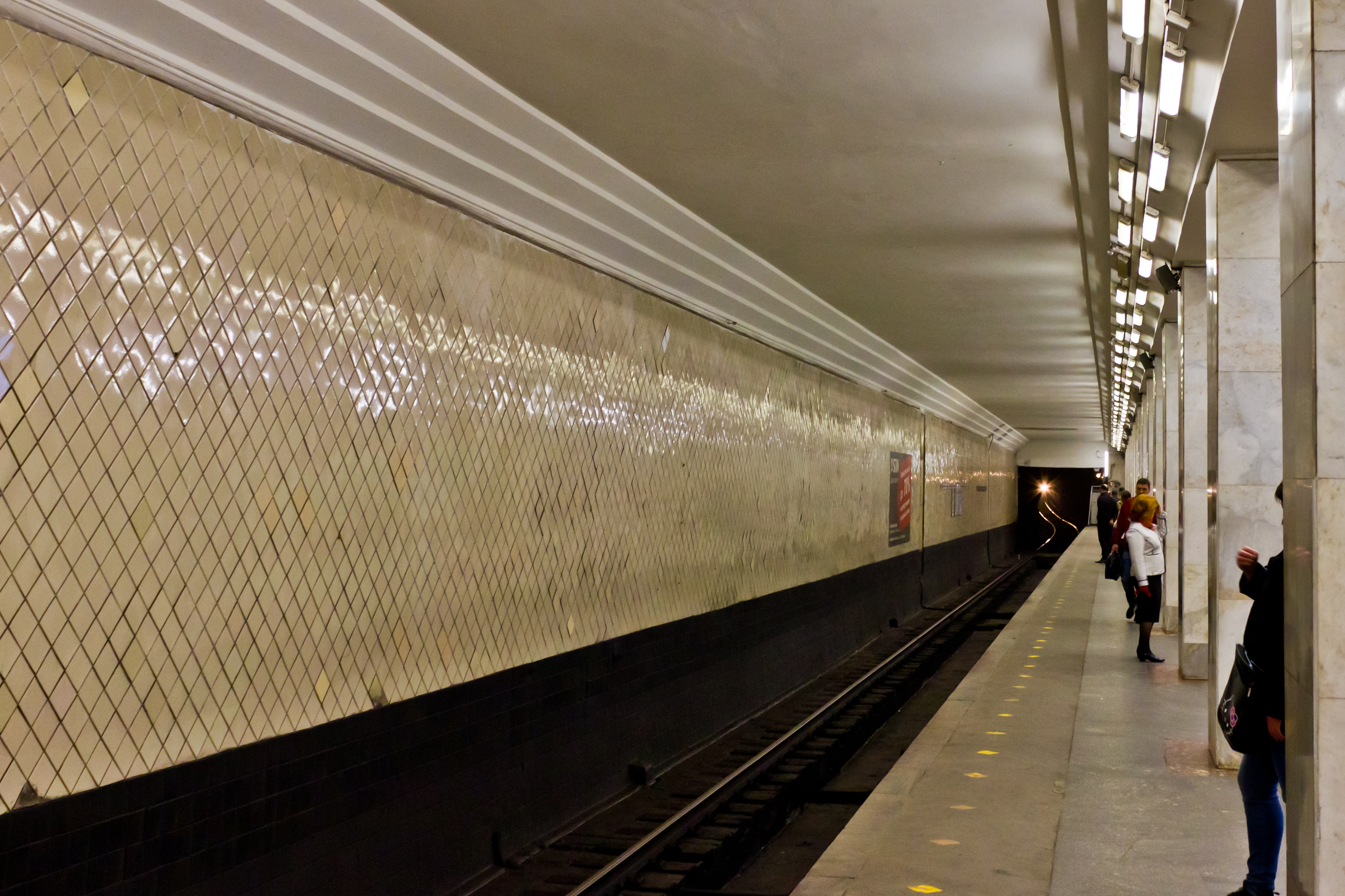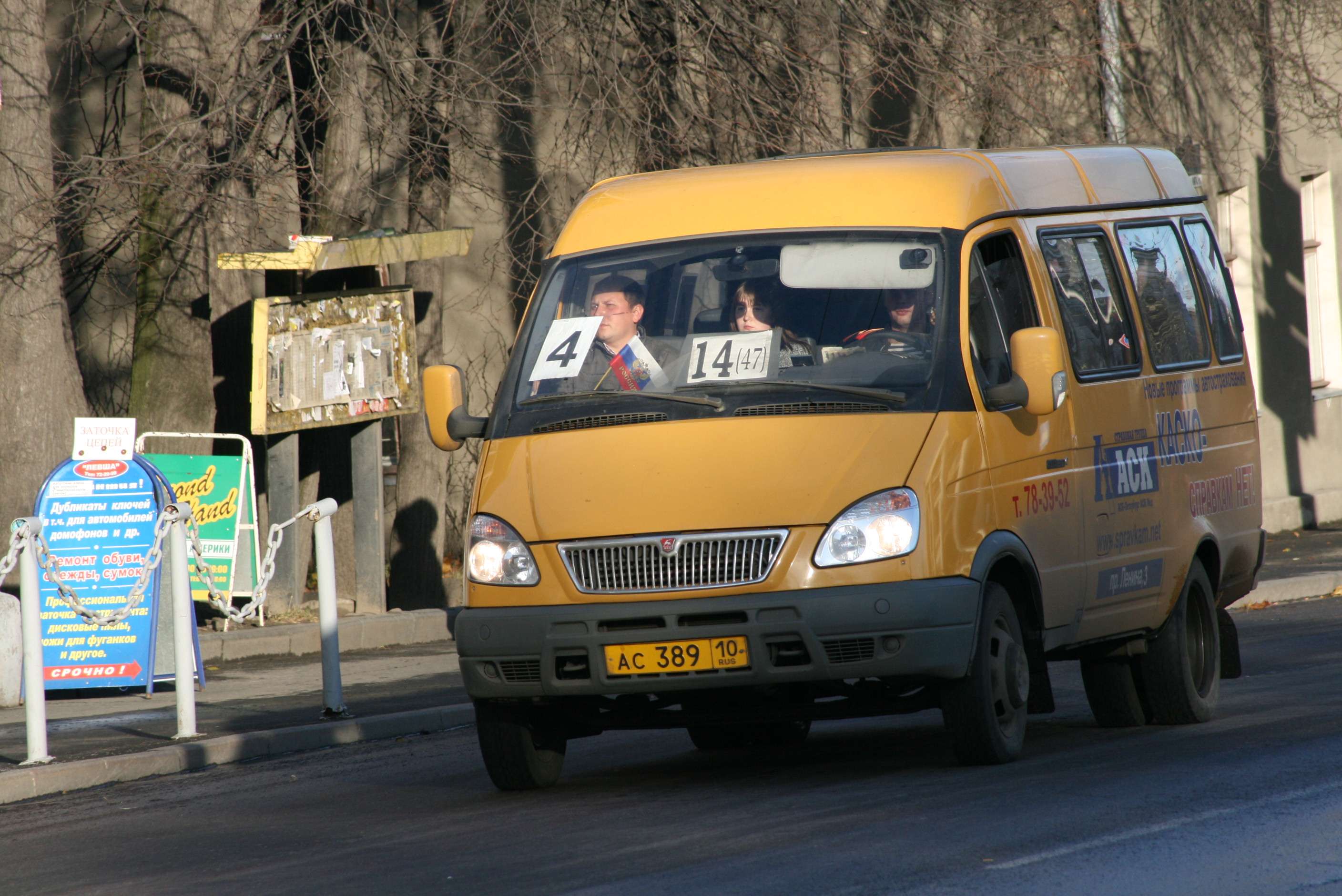|
Leninsky Prospekt (Saint Petersburg Metro)
Leninsky Prospekt (russian: Ле́нинский проспе́кт, en, Leninsky Avenue) is a station on the Kirovsko-Vyborgskaya Line of the Saint Petersburg Metro, located between Avtovo and Prospekt Veteranov. The station was opened on 29 September 1977 in the section between Avtovo and Prospekt Veteranov, replacing the temporary surface station Dachnoye. It is named after the street of the same name, where one of the entrances is located. Station facilities There is no above-ground pavilion; entrance to the station is provided through underground pedestrian crossings, with exits onto Leninsky Prospekt and Bulvar Novatorov. Because of the station's shallow depth, neither exit has escalators. Leninsky Prospekt is a shallow column station with a depth of . The underground hall was constructed as a project of the architects A. S. Getskin and Ye. I. Val and the engineer A. N. Yakovlev. The design of the station echoes Lenin's Mausoleum. The platforms and the columns, w ... [...More Info...] [...Related Items...] OR: [Wikipedia] [Google] [Baidu] |
Kirovsky District, Saint Petersburg
Kirovsky District (russian: Ки́ровский райо́н) is a district of the federal city of St. Petersburg, Russia. As of the 2010 Census, its population was 334,746; down from 338,820 recorded in the 2002 Census. Municipal divisions Kirovsky District comprises the following seven municipal okrugs:Law #411-68 *Avtovo Avtovo (russian: А́втово) is a station on the Kirovsko-Vyborgskaya Line of the Saint Petersburg Metro. Designed by architect , it opened as part of the first Leningrad Metro line on November 15, 1955. In 2014, The Guardian included it on t ... * Dachnoye * Knyazhevo * Krasnenkaya Rechka * Morskiye Vorota * Narvsky * Ulyanka References Notes Sources * External links * {{Use mdy dates, date=November 2014 __NOTOC__ ... [...More Info...] [...Related Items...] OR: [Wikipedia] [Google] [Baidu] |
Karelia
Karelia ( Karelian and fi, Karjala, ; rus, Каре́лия, links=y, r=Karélija, p=kɐˈrʲelʲɪjə, historically ''Korjela''; sv, Karelen), the land of the Karelian people, is an area in Northern Europe of historical significance for Russia (including the Soviet era), Finland, and Sweden. It is currently divided between northwestern Russia (specifically the federal subjects of the Republic of Karelia and Leningrad Oblast) and Finland (the regions of South Karelia, North Karelia, and the eastern portion of modern-day Kymenlaakso). Use of name Various subdivisions may be called Karelia. Finnish Karelia was a historical province of Finland, and is now divided between Finland and Russia, often called just ''Karjala'' in Finnish. The eastern part of this chiefly Lutheran area was ceded to Russia after the Winter War of 1939–40. The Republic of Karelia is a Russian federal subject, including East Karelia with a chiefly Russian Orthodox population. Within present-da ... [...More Info...] [...Related Items...] OR: [Wikipedia] [Google] [Baidu] |
Saint Petersburg Metro Stations
In religious belief, a saint is a person who is recognized as having an exceptional degree of holiness, likeness, or closeness to God. However, the use of the term ''saint'' depends on the context and denomination. In Catholic, Eastern Orthodox, Anglican, Oriental Orthodox, and Lutheran doctrine, all of their faithful deceased in Heaven are considered to be saints, but some are considered worthy of greater honor or emulation. Official ecclesiastical recognition, and consequently a public cult of veneration, is conferred on some denominational saints through the process of canonization in the Catholic Church or glorification in the Eastern Orthodox Church after their approval. While the English word ''saint'' originated in Christianity, historians of religion tend to use the appellation "in a more general way to refer to the state of special holiness that many religions attribute to certain people", referring to the Jewish tzadik, the Islamic walī, the Hindu rishi or Sikh g ... [...More Info...] [...Related Items...] OR: [Wikipedia] [Google] [Baidu] |
Leninsky Prospekt (Moscow Metro)
Leninsky Prospekt (russian: Ленинский проспект English: Lenin Avenue) is a station on the Kaluzhsko-Rizhskaya Line of the Moscow Metro. It was built in 1962 to a variant of the standard column tri-span design, which included a more vaulted central span. The pillars are faced with white marble with a strip of gray at the base and the outer walls are tiled. The original metal light fixtures still run the length of each platform span were replaced in 2004 with more utilitarian fluorescent fixtures. The architects of the station are A. Strelkov, Nina Alexandrovna Aleshin, Yuriy Vdovin, V. Polikarpov and A. Marova. Leninsky Prospekt has two entrances, interlinked with subways on the east side of the Leninsky Avenue after which it was named and with exists also to both sides of the Yuri Gagarin Square. Currently the station serves 61,600 passengers daily. In the middle of a platform there is a staircase allowing transfer to Ploschad Gagarina station of the Moscow C ... [...More Info...] [...Related Items...] OR: [Wikipedia] [Google] [Baidu] |
Marshrutka
''Marshrutka''Urban transportation systems: choices for communities (p. 254). Sigurd Grava. McGraw-Hill Professional, 2003. 840 pp. 0071384170, 9780071384179. or ''marshrutnoe taksi''THE COMPARATIVE ANALYSIS OF ENGLISH AND LITHUANIAN: TRANSPORT TERMS AND SOME METHODS OF DEVELOPING EFFECTIVE SCIENCE WRITING STRATEGIES BY NON ... [...More Info...] [...Related Items...] OR: [Wikipedia] [Google] [Baidu] |
Trolleybus
A trolleybus (also known as trolley bus, trolley coach, trackless trolley, trackless tramin the 1910s and 1920sJoyce, J.; King, J. S.; and Newman, A. G. (1986). ''British Trolleybus Systems'', pp. 9, 12. London: Ian Allan Publishing. .or trolleyDunbar, Charles S. (1967). ''Buses, Trolleys & Trams''. Paul Hamlyn Ltd. (UK). Republished 2004 with or 9780753709702.) is an electric bus that draws power from dual overhead wires (generally suspended from roadside posts) using spring-loaded trolley poles. Two wires, and two trolley poles, are required to complete the electrical circuit. This differs from a tram or streetcar, which normally uses the track as the return path, needing only one wire and one pole (or pantograph). They are also distinct from other kinds of electric buses, which usually rely on batteries. Power is most commonly supplied as 600-volt direct current, but there are exceptions. Currently, around 300 trolleybus systems are in operation, in cities and towns in 4 ... [...More Info...] [...Related Items...] OR: [Wikipedia] [Google] [Baidu] |
Ploshchad Lenina (Saint Petersburg Metro)
Ploshchad Lenina (russian: Пло́щадь Ле́нина, Lenin Square) is a station on the Kirovsko-Vyborgskaya Line of the Saint Petersburg Metro, located between Chernyshevskaya and Vyborgskaya. The station was opened on June 1, 1958, on the second line of the metro between Ploshchad Vosstaniya and Ploshchad Lenina. It was named after Lenin Square, the location of its surface vestibule. In the early plans, it was named "Finland Station." Surface vestibules The surface vestibule of the station was designed by architect A.K. Andreev. It was built into the Finlyandsky Rail Terminal building. The wall of the entrance hall is decorated with a panoramic mosaic that commemorates Lenin's speech before the workers and soldiers of Petrograd on April 3, 1917. It was created by artists A.I. Mylnikov and A.L. Korolyov. In 1962, Andreev worked together with Yu.N. Kozlov and the engineer Ye.A. Erganov to design and complete second entrance from Botkinskoy street. Both entrances a ... [...More Info...] [...Related Items...] OR: [Wikipedia] [Google] [Baidu] |
Cut And Cover
A tunnel is an underground passageway, dug through surrounding soil, earth or rock, and enclosed except for the entrance and exit, commonly at each end. A Pipeline transport, pipeline is not a tunnel, though some recent tunnels have used immersed tube construction techniques rather than traditional tunnel boring methods. A tunnel may be for foot or vehicular road traffic, for rail transport, rail traffic, or for a canal. The central portions of a rapid transit network are usually in the tunnel. Some tunnels are used as sanitary sewer, sewers or aqueduct (watercourse), aqueducts to supply water for consumption or for hydroelectric stations. Utility tunnels are used for routing steam, chilled water, electrical power or telecommunication cables, as well as connecting buildings for convenient passage of people and equipment. Secret tunnels are built for military purposes, or by civilians for smuggling of weapons, contraband, or people. Special tunnels, such as wildlife crossi ... [...More Info...] [...Related Items...] OR: [Wikipedia] [Google] [Baidu] |
Marble
Marble is a metamorphic rock composed of recrystallized carbonate minerals, most commonly calcite or Dolomite (mineral), dolomite. Marble is typically not Foliation (geology), foliated (layered), although there are exceptions. In geology, the term ''marble'' refers to metamorphosed limestone, but its use in stonemasonry more broadly encompasses unmetamorphosed limestone. Marble is commonly used for Marble sculpture, sculpture and as a building material. Etymology The word "marble" derives from the Ancient Greek (), from (), "crystalline rock, shining stone", perhaps from the verb (), "to flash, sparkle, gleam"; Robert S. P. Beekes, R. S. P. Beekes has suggested that a "Pre-Greek origin is probable". This Stem (linguistics), stem is also the ancestor of the English language, English word "marmoreal," meaning "marble-like." While the English term "marble" resembles the French language, French , most other European languages (with words like "marmoreal") more closely resemb ... [...More Info...] [...Related Items...] OR: [Wikipedia] [Google] [Baidu] |
Granite
Granite () is a coarse-grained (phaneritic) intrusive igneous rock composed mostly of quartz, alkali feldspar, and plagioclase. It forms from magma with a high content of silica and alkali metal oxides that slowly cools and solidifies underground. It is common in the continental crust of Earth, where it is found in igneous intrusions. These range in size from dikes only a few centimeters across to batholiths exposed over hundreds of square kilometers. Granite is typical of a larger family of ''granitic rocks'', or ''granitoids'', that are composed mostly of coarse-grained quartz and feldspars in varying proportions. These rocks are classified by the relative percentages of quartz, alkali feldspar, and plagioclase (the QAPF classification), with true granite representing granitic rocks rich in quartz and alkali feldspar. Most granitic rocks also contain mica or amphibole minerals, though a few (known as leucogranites) contain almost no dark minerals. Granite is nearly alway ... [...More Info...] [...Related Items...] OR: [Wikipedia] [Google] [Baidu] |
Lenin's Mausoleum
Lenin's Mausoleum (from 1953 to 1961 Lenin's & Stalin's Mausoleum) ( rus, links=no, Мавзолей Ленина, r=Mavzoley Lenina, p=məvzɐˈlʲej ˈlʲenʲɪnə), also known as Lenin's Tomb, situated on Red Square in the centre of Moscow, is a mausoleum that serves as the resting place of Soviet leader Vladimir Lenin. His preserved body has been on public display there since shortly after his death in 1924, with rare exceptions in wartime. Alexey Shchusev's granite structure incorporates some elements from ancient mausoleums, such as the Step Pyramid, the Tomb of Cyrus the Great and, to some degree, the Temple of the Inscriptions. History Lenin died on 21 January 1924. Two days later, architect Alexey Shchusev was tasked with building a structure suitable for viewing of the body by mourners. A wooden tomb, in Red Square by the Moscow Kremlin Wall, was ready on January 27, and later that day Lenin's coffin was placed in it. More than 100,000 people visited the tomb in the ... [...More Info...] [...Related Items...] OR: [Wikipedia] [Google] [Baidu] |
Saint Petersburg
Saint Petersburg ( rus, links=no, Санкт-Петербург, a=Ru-Sankt Peterburg Leningrad Petrograd Piter.ogg, r=Sankt-Peterburg, p=ˈsankt pʲɪtʲɪrˈburk), formerly known as Petrograd (1914–1924) and later Leningrad (1924–1991), is the second-largest city in Russia. It is situated on the Neva River, at the head of the Gulf of Finland on the Baltic Sea, with a population of roughly 5.4 million residents. Saint Petersburg is the fourth-most populous city in Europe after Istanbul, Moscow and London, the most populous city on the Baltic Sea, and the world's northernmost city of more than 1 million residents. As Russia's Imperial capital, and a historically strategic port, it is governed as a federal city. The city was founded by Tsar Peter the Great on 27 May 1703 on the site of a captured Swedish fortress, and was named after apostle Saint Peter. In Russia, Saint Petersburg is historically and culturally associated with t ... [...More Info...] [...Related Items...] OR: [Wikipedia] [Google] [Baidu] |







.jpg)
